Stainless Steel Kitchen Sinks
Stainless steel kitchen sinks possess great qualities that make them a good choice for just about any kitchen. Their look is timeless and complements other stainless appliances. They can be rugged and durable but quality construction is important in obtaining longevity and satisfactory performance.
Before running out to buy one of these sinks there are points to consider about the type of steel used in its construction, it's thickness and other important design features.
Other considerations include the type of finish the sink has since there are several to choose from, and the overall style and configuration that you want.
Finally, it helps to understand the care and maintenance that's involved with a stainless sink, particularly if you're someone who cares a lot about how your sink will look over time.
What To Know & How To Choose A Stainless Steel Sink
Stainless Steel - What It Is
Stainless steel in its simplest terms is steel that has been alloyed or "combined with" other elements that give it more beneficial properties than it would otherwise have on its own.Two of these important elements that you'll see (or should see) on specs for these sinks are chromium and nickel. They enhance the quality of the steel, giving it strength and corrosion resistance.
Stainless sinks are usually labeled with the amount of chromium and nickel contained in the steel. It's usually designated by a ratio like "18:8" or something equivalent. This particular example means there is 18% chromium and 8% nickel in the stainless steel. The higher the percentage of these elements that are present, the better the grade of stainless steel.
The grade is specified by its "series" number. Most stainless steel sinks are usually in the "300" series, usually 304 to be specific. This is a good quality steel with 18:8 to 20:10 chromium/nickel content.
The important point in all this is that by understanding some of the key characteristics of stainless steel, you'll be better able to judge quality sinks when comparing various brands and their specifications.
Gauge (Thickness Of The Material)
"Gauge" refers to the thickness of the metal used to make the sink. The important point to remember relative to gauge is that smaller gauge numbers mean thicker material. Yes, it's counter-intuitive but that's the way it was established long ago.Stainless sink thicknesses ranges from 16 gauge (thicker) to 22 gauge (thin). The benefit of thicker material is that it's more resistant to dings and dents, is less "noisy" than a thinner gauge sink and more robust in terms of handling things like the vibration associated with a garbage disposal. Good quality stainless steel sinks are usually 16 to 18 gauge.
Insulation and Coatings
Stainless steel sinks can be fitted with sound insulation and coatings to help deaden sound attenuation. It can also act to reduce condensation buildup on the bottom of the sink that could lead to moisture problems in the base cabinet that the sink is installed in. Not all stainless sinks come with this feature but it's worth consideration for reducing the tinny sound, particularly from thinner gauge sinks.
Finish
Finish refers to the surface smoothness of the stainless steel material. A mirror finish has a high polish and is very smooth whereas a brushed finish is duller and more "frosted" in appearance. Most finishes, except for the polished mirror finishes, will exhibit a uniform "grain" direction that results from the brushing/finishing process.Care & Maintenance
Knowing how to clean a stainless sink will help maintain its lustre and beauty over time while avoiding potential problems with the finish.The first consideration should be to consult the manufacturer's cleaning and care recommendations to make sure you're not doing anything that will either ruin your sink and/or void it's warranty. The procedures are pretty consistent among most manufacturers so you shouldn't find many differences.
Caution is required when using more aggressive cleaners and scrubbing methods to avoid scratching or marring the surface. Any scrubbing should be done in the steel's grain direction to avoid unsightly smudges and scratches in the surface.
Stainless steel doesn't like chloride compounds which are found in many soaps, cleaners and detergents and they can harm the steel's surface. The good news is that these chlorides are water soluble so thoroughly rinsing out the sink after using these types of cleaners should prevent any problems.
Avoid using steel wool to scrub the sink's surface. Very small bits of steel from the scouring pad can get embedded in the stainless steel surface. These bits (which are NOT made of stainless steel) will rust over time resulting in rust stains on the sink.
Finally, there's the issue of dullness and water-spotting that inevitably occurs with this kind of sink. There are lovers and haters of stainless sinks and the main reason cited by the haters is that the sink looks like a mess not long after it's used. Unless you wipe it clean after every use (which can get annoying pretty quickly) it'll show water spots and soap scum. If you're ok with that, no problem. Just be aware that if you want a showroom-clean sink most of the time, you're going to have to commit to some daily maintenance.
How To Make A Good Choice
Choosing a good stainless sink is simply a matter of pairing your style preferences with the level of quality relative to the characteristics of the material mentioned above.- Decided on your preferences - double/single bowl, rounded or 90-degree corners, etc.
- Look for quality material - 304 stainless is a good, durable grade of material.
- Choose a sweet-spot gauge thickness that meets your budget - 16 gauge is very good, 18 is thinner but still acceptable.
- Choose a sink that's undercoated to help insulate it relative to noise and water temperature.
- Look for sinks with a good (such as lifetime) warranty.
The Pros & Cons Of A Stainless Steel Sink
Like virtually any product for your home there are pros and cons and stainless steel kitchen sinks are no different.
First, the positives...
- Durability and longevity - Quality sinks with reasonable care should last forever. They're made from a corrosion resistant steel that's harder and tougher than other types of materials and won't chip, crack or wear out.
- Affordability - Yes, you can pay over a thousand dollars for some high-end stainless triple bowl kitchen sinks but there are plenty of very affordable models that provide the benefits stainless sinks have to offer.
- Timeless look consistent with many appliances - depending on your perspective and taste, stainless steel sinks provide a consistent look in a kitchen with stainless appliances. Even without these types of appliances, stainless steel sinks have consistently been in fashion and immune from fluctuating style trends.
- Sanitary surface - Stainless steel sinks are easy to clean and non-porous giving little refuge to bacteria and other nasties.
- Bigger bowl capacity - Stainless steel's relatively light yet strong properties allow it to be formed into larger and deeper bowls that might not otherwise be feasible with cast iron or other materials.
- And it's recyclable - If you like the idea of buying products that can be recycled at the end of their life instead of ending up in a landfill, a stainless steel sink is one that'll meet that requirement.
- Not immune to scratching - Even though they're metal you can still put scratches in a stainless steel sink. They also have a "grain direction" and any rubbing with an abrasive material in the direction opposite of the grain will result in visible scratches and/or a blotchy appearance inconsistent with he rest of the sink.
- There's maintenance involved in keeping it looking good - Stainless sinks are relatively easy to clean as they don't really stain but keeping them looking new and fresh takes effort. Dried mineral deposits from standing water and drips can make a stainless steel sink look dingy pretty quickly. You'll need to wipe out the sink frequently to avoid the drab filmy look.
- The noise issue - This is somewhat subjective but some people just don't like the "tinny" sound that's associated with a stainless steel sink. Coatings added to the bottom help deaden that sound but the nature of the beast is that it will just naturally sound metallic -- the degree depends on the thickness of the material and whether the sink is coated, both of which add mass and help reduce sound attenuation.
Interesting Products & Options To Know About
If you think all stainless steel kitchen sinks are simple basins, think again. They can be as simple as a drop-in single bowl style or as fancy as a triple bowl design with integral perforated drain boards and removable platforms.
The point is, there are lots of options and styles to choose from. We've listed some highlights of stainless sink design to whet your curiosity. At the least it may make you aware of some feature you didn't know about and give you something to consider as you shop for a stainless sink.
- Zero-Radius Corners
One style trend is the zero-radius sink that emulates commercial and restaurant style sinks. The corners of these sinks are typically very sharp (90-degrees) with no curve or radius. One consideration however is the effort required to clean those tight corners - they're not as "open" as traditional sinks with gentle curved corners.Julien's Urban Edge® and Elkay's Avado™ are two examples of sinks that exhibit this modern styling.
- Recyclability and "Green-ness"
Stainless steel is a recyclable material and many sinks are made from salvaged raw material. Stainless steel doesn't degrade or lose any of its properties in the recycling process making stainless steel sinks a good green option. Some manufacturers like Julien feature sinks made from 90% recycled material. - Stainless Steel Apron Sinks
Do you like the style of a farmhouse sink but want it in stainless steel? They're available. Kraus makes several very good varieties with a modern twist that are characterized by a slight curve on the apron front. Photo Courtesy Of Elkay
Photo Courtesy Of ElkayJulien has an apron front stainless sink in their UrbanEdge® and Classic collections. Elkay's Elite Gourmet and Gourmet series sinks feature stainless farmhouse sinks.
Kohler offers two styles of stainless apron front sinks in their Verity® line. One is an undermount style while the other is a countertop (drop-in) style with a 4" apron that surrounds the sink on top of the countertop surface.
Blanco includes several apron front stainless sinks within their BlancoMagnum Series. Sinks are 18 gauge, include double and single bowl designs and are treated with a satin finish.
Not to be outdone, Houzer makes several models of 16 gauge stainless steel apron sinks. Their Epicure line contains models made from a combination of 16 and 18 gauge material.
Learn more about your stainless apron front sink options and best choices here.
- Added Features, Options and Product Enhancements
Many stainless sink manufacturers offer added features and product enhancements. Each maker has their own brand of sound suppression coatings and silencer pads.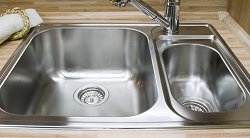
Other options include grids to reduce scrapes on the sink bottom and removable cutting boards shaped to fit a portion of the sink. This allows you to process food right at the sink while still maintaining access to the sink's drain and garbage disposal.
- High Design and High Functionality
If you're looking for a stainless kitchen sink style that's a conversation starter, consider Elkay's Design Inspirations 08™ featuring the creativity of two top American designers, Jamie Drake and Fu-Tung Cheng. These designers have developed sinks with very unique styling and features sure to add distinctiveness not found in every kitchen.Multi-function sinks feature tools and design attributes that make the primary sink not only a workhorse but an efficient one at that. Kohler's PRO TaskCenter™ sinks come in double and triple bowl designs and feature accessories like wire racks, strainers and added removable basins for making food prep and cleanup available in one location.
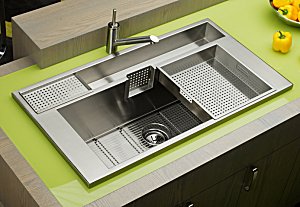 Photo Of Elkay Avado®Accent - Courtesy of Elkay
Photo Of Elkay Avado®Accent - Courtesy of ElkayElkay's professional grade Avado Accent drop-in sinks aim for efficiency and functionality with several versions and options available. Multi-bowl designs with varied-depth basins redefine multi-tasking sinks and kitchen space efficiency. These models feature commercial grade 16 gauge stainless steel in a polished satin finish with zero-radius corners.
Publisher's Comments --
My Top Stainless Sink Recommendation & Where To Buy
Product choices, particularly on items like kitchen sinks that come in virtually every shape, size and color under the sun are highly subjective. We all have our preferences. But my job wouldn't be complete if I didn't help you by at least making a recommendation on what I think are some good stainless sink options.
My criteria is this: the products I recommend are based on my research, with an emphasis on quality and value, as if I'm shopping with my own self-interests in mind. If it's something I'd buy, I feel confident in recommending it. Aesthetics are a more personal preference so I try and leave that out of the equation, unless I simply can't contain my enthusiasm about a particular product.
Best Overall Stainless Steel Sink (Undermount)
From my perspective the best 'all around' stainless steel undermount sink is made by Kraus. It's a perfect blend of a good finish, durability and price. It's made from 16 gauge steel which is generous at the price you can buy these sinks for. It's also equipped with two types of sound absorbing/insulating materials - rubber pads and a coating on top of that.When you combine that with the fact that the sink also comes with a stainless steel bottom grid and a drain with an integral strainer basket, it's hard to beat the value (lots of sinks require that you purchase the sink drain separately).
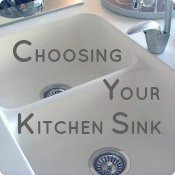
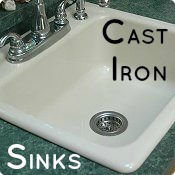
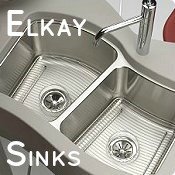
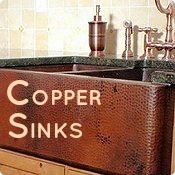
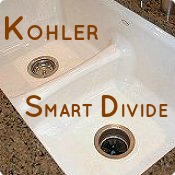
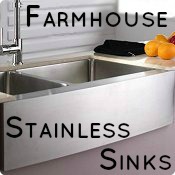
Publisher's Comments
I found it interesting that the Consumer Reports Kitchen Planning & Buying Guide reports that gauge thickness wasn't a factor in sound attenuation or resistance to dents and scratches based on their tests. That may be true but it comes down to what you ultimately want for the money you spend.
At the time of this writing, a quick internet search showed me that I could pay $50 for a 22 gauge 33"x22" double bowl , drop-in sink or $128 for an 18 gauge sink the same size and configuration.
If you're on a tight budget, the price difference between $128 and $50 might be significant. But I think it's fair to say that it's not that big of a price differential for a more robust material thickness. Maybe it's the engineer in me but I like products that are thicker rather than thinner, particularly if there's not much of a difference in price. It indicates a level of quality, all other things being equal, that I'd rather have, regardless of Consumer Reports' findings.